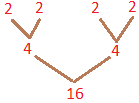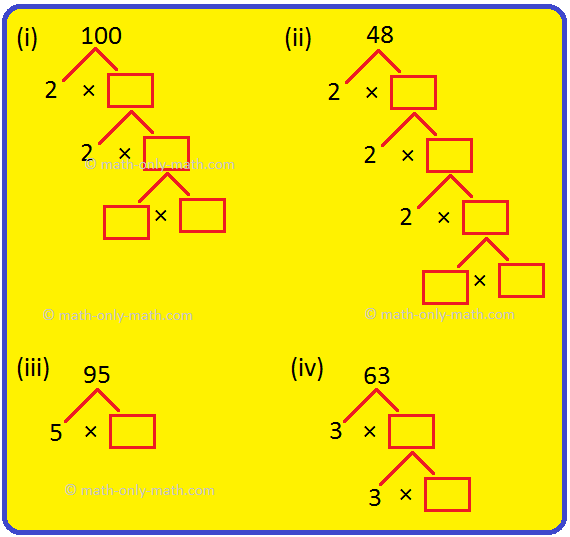Subscribe to our ▶️ YouTube channel 🔴 for the latest videos, updates, and tips.
Methods of Prime Factorization
In prime factorization, we factorize the numbers into prime numbers, called prime factors.
Expressing a number as the product of its factors is called factorization.
For example, 48 = 2 × 24
Here, 48 in factorised.
There are many other forms of factorization of 48.
Such as 48 = 2 × 2 × 12
= 2 × 2 × 2 × 2 × 3
48 = 2 × 2 × 2 × 2 × 3, we see that each factor of 48 is a prime number.
It is called prime factorization.
When a number is expressed as a product of prime numbers, we call it prime factorization.
or
A factorization is which every factor is prime, is called the prime factorization of the number.
Prime factorization of 30 and 48 are given below:
30 = 2 × 3 × 5
48 = 2 × 2 × 2 × 2 × 3
To make the prime factorization of a number, we divide the given number by the prime number 2, 3, 5, 7, 11, etc., in this order repeatedly so long as the quotient is divisible by that number.
There are two methods of prime factorization:
Factorization means writing a given number as the product of two or more factors.
Prime factorization of a number is a way of showing a number as the product of prime numbers.
There are 2 methods to find the prime factors.
1. Division Method
2. Factor Tree Method
1. Prime Factorization by Division Method:
Observe the following steps.
I: First we divide the number by the smallest prime number which divides the number exactly.
II: We divide the quotient again by the smallest or the next smallest prime number if it is not exactly divisible by the smallest prime number. We repeat the process again and again till the quotient becomes 1. Remember, we use only prime numbers to divide.
III: We multiply all the prime factors. Remember, the product is the number itself.
Let us consider a few examples using division method.
1. Find the prime factors of 15.
First Step: 2 is the smallest prime number. But it cannot divide 15 exactly. So, consider 3.
Second Step: Now, 5 cannot be divide by 3. Consider the next smallest prime number 5.
The prime factors of 15 are 3 × 5.
2. Find the prime factors of 18.
First Step: Consider 2, the smallest prime number.
Second Step: As 9 cannot be divide by 2. Consider the next smallest prime 3. Repeat the process till quotient becomes 1.
The prime factors of 18 are 2 × 3 × 3.
2. Prime Factorization by Factor Tree Method
Observe the following steps.
Suppose, we have to find the prime factors of 16
1. We consider the number 16 as the root of the tree.
2. We write a pair of factors as the branches of the tree i.e., 2 × 8 = 16
3. We further factorize the composite factor 8 as 4 and 2, and again the composite factors 4 as 2 and 2.
We repeat the process again till we get the prime factors of all the composite factors.
2 × 8 = 16
2 × 4 × 2 = 16
2 × 2 × 2 × 2 = 16
The prime factors of 16 = 2 × 2 × 2 × 2.
We can express the factor tree to find the prime factors of 16 in another way also.
4 × 4
2 × 2 × 2 × 2
The prime factors of 16 = 2 × 2 × 2 × 2.
Now, we will use both the methods (Factor Tree Method and Division Method) to the prime factorization of a number:
1. The prime factorization of 36
Factor Tree Method
Continue factorizing until only prime number remains.
36 = 2 × 2 × 3 × 3
Division Method
Continue diving unit the quotient is a prime.
2. The prime factorization of 64.
Factor Tree Method
Continue factorizing until only prime number remains.
64 = 2 × 2 × 2 × 2 × 2 × 2
Division Method
Continue diving unit the quotient is a prime.
More Solved Examples on Methods of Prime Factorization:
3. Express 240 as the product of prime numbers.
Division Method
Hence, 240 = 2 × 2 × 2 × 2 × 3 × 5
This process can be shown diagramatically, known as factor tree.
Factor Tree Method:
Therefore, 240 = 2 × 2 × 2 × 2 × 3 × 5
4. Draw a factor tree to show the prime factorization of 42, 96 and 108.
Therefore, 42 = 2 × 3 × 7
108 = 2 × 2 × 3 × 3 × 3
96 = 2 × 2 × 2 × 2 × 2 × 3.
Worksheet on Methods of Prime Factorization:
I. Prime factorize the following numbers using division method.
(i) 18
(ii) 125
(iii) 512
(iv) 144
(v) 360
(vi) 256
(vii) 96
(viii) 80
(ix) 625
(x) 169
Answer:
I. (i) 2 × 3 × 3
(ii) 5 × 5 × 5
(iii) 2 × 2 × 2 × 2 × 2 × 2 × 2 × 2 × 2
(iv) 2 x 2 x 2 x 2 x 3 x 3
(v) 2 × 2 × 2 × 3 × 3 × 5
(vi) 2 × 2 × 2 × 2 × 2 × 2 × 2 × 2
(vii) 2 × 2 × 2 × 2 × 2 × 3
(viii) 2 × 2 × 2 × 2 × 5
(ix) 5 × 5 × 5 × 5
(x) 13 × 13
II. Find the prime factors using the factor tree.
(i) 66
(ii) 75
(iii) 24
(iv) 156
(v) 128
Answer:
II. (i) 2 × 3 × 11
(ii) 3 × 5 × 5
(iii) 2 × 2 × 2 × 3
(iv) 2 × 2 × 3 × 13
(v) 2 × 2 × 2 × 2 × 2 × 2 × 2
III. Copy and complete these factor trees.
Answer:
III. (i) 2 × 2 × 5 × 5
(ii) 2 × 2 × 2 × 2 × 3
(iii) 5 × 19
(iv) 3 × 3 × 7
IV. Write the prime factorization of 24.
Answer: Prime factorization of 24 = 2 × 2 × 2 × 3
V. Draw a factor tree to show the prime factorisation of:
(i) 40
(ii) 98
(iii) 120
Answer:
V. (i)
(ii)
(iii)
VI. Write the prime factorization of 96.
Answer: Prime factorization of 96 = 2 × 2 × 2 × 2 × 2 × 3
From Methods of Prime Factorization to HOME PAGE
Didn't find what you were looking for? Or want to know more information about Math Only Math. Use this Google Search to find what you need.















New! Comments
Have your say about what you just read! Leave me a comment in the box below. Ask a Question or Answer a Question.